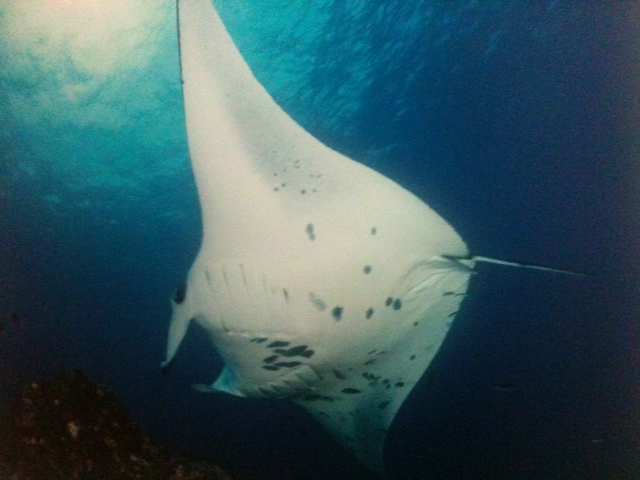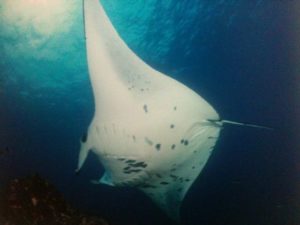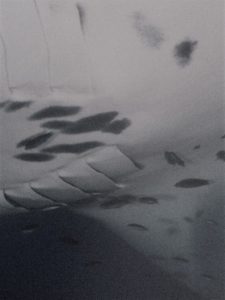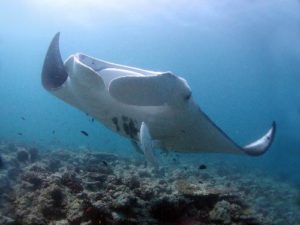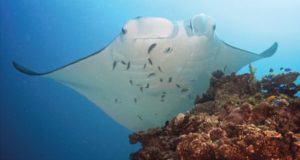A couple of things this week have spurred me on to write a couple of additional things about “Tropical Fish Cleaners and Their Mimics”.
It started with a photo of a Bluestreak cleaner wrasse, Labroides dimidiatus, cleaning in the mouth of a giant moray, Gymnothorax javanicus, in Egypt (the Red Sea) on The Global Diving Community Facebook page. It had been posted by Ernst Andres. My immediate thought was to add the photo to my “Tropical Fish Cleaners and Their Mimics” article.
Then I was watching David Attenborough’s “Great Barrier Reef – The Visitors” (Part 2 of 3) on ABC TV for the second time. It featured a large manta rays visiting a cleaning station. Once that the program had ended, I made a few notes to help me to remember the details.
According to Wikipedia, there are two species of manta ray – the Coastal Manta Ray and the Giant Oceanic Manta Ray*. The Giant Oceanic (or Pelagic) Manta, Manta birostris, is the largest of the two. Wikipedia says that Manta birostris reach 7 m in width, while the Coastal (or Reef) Manta, Manta alfredi, reach a width of 5.5 m.
Another thing that may have spurred me on somewhat is this picture on my hallway wall: –
A manta ray picture on my hallway wall
David Attenborough’s “Great Barrier Reef” showed a pair of large mantas (Manta alfredi?) visiting a Bluestreak cleaner wrasse cleaning station. Filming or photographing manta rays at a cleaner station was said to assist with the identification of different mantas.
Many wrasses were shown attending to each of the two mantas, each wrasse cleaning a different area on the rays. It was suggested that each wrasse was assigned to its own little area to clean.
The cleaning came to an abrupt end when one of the cleaner wrasses got a little carried away and took a bite out of the manta that it was helping to clean. The annoyed manta shook off the cleaners and swam away without them.
The offending cleaner was a female and she was quickly scolded by a large male cleaner for her carelessness. The cleaners don’t want to lose a host who may never return to be cleaned again. It seemed that the largest male cleaner was responsible for keeping the group in line.
Here is a close-up of the picture on my hallway wall: –
A close-up of the picture on my hallway wall. Several fish can be seen on the underside of the manta.
Fish such as the manta rays may return for cleaning as long as the incident was not too severe.
Here is a photo of a Giant Oceanic (or Pelagic) Manta, Manta birostris, at a cleaning station at Ari Atoll in the Maldives: –
Manta ray on cleaning station (Manta birostris)
(Source: Marine Photobank. Copyright Konstantin Tkachenko/Marine Photobank)
After watching David Attenborough’s “Great Barrier Reef”, I decided to take another look at my library of books for any reference to cleaner wrasses cleaning manta rays. I hadn’t realised before that a section of my Lonely Planet book titled “Diving & Snorkeling Maldives” by Casey Mahaney & Astrid Witte Mahaney (2001) includes a page about manta rays (pages 52-53).
It is actually about a location in the Maldives called Manta Point, south-east of Lankanfinolhu. (The Maldives are an archipelago of atolls in the Indian Ocean.) It says that Manta Point is a famous site for divers to experience manta ray encounters. These occur mostly during the south-west monsoon season. There are manta cleaner stations wherever ‘shallow coral rocks rise from the reef slope’. Mantas are said to “come in from the deep, then circle or hover “in line” to benefit from the services cleaner wrasses provide” and “These busy little fish pluck parasites and dead skin cells off the grateful mantas. Patient divers who remain quiet and don’t touch or swim after the mantas are often able to observe this ritual up close.”
Here is a photo of a Coastal or Reef Manta, Manta alfredi, at a cleaning station atop a coral patch, maintaining a near stationary position to be cleaned by cleaner fishes: –
Manta alfredi at a coral reef cleaning station with fish picking off parasites
(Source: https://dx.doi.org/10.1371/journal.pone.0046170.g002, CC BY 2.5, It comes from “When Giants Turn Up: Sighting Trends, Environmental Influences and Habitat Use of the Manta Ray” by Jaine FRA, Couturier LIE, Weeks SJ, Townsend KA, Bennett MB, et al. (2012), PLoS ONE 7(10): e46170 https://dx.doi.org/10.1371/journal.pone.0046170 .)
* (According to Wikipedia at https://en.wikipedia.org/wiki/Mobula however, “Based on genetic and to a lesser degree morphological evidence, the genus was redefined in 2017. Under this arrangement, Manta is included in Mobula (Ref. White; Corrigan; Yang; Henderson; Bazinet; Swofford; and Naylor (2017). “Phylogeny of the manta and devilrays (Chondrichthyes: mobulidae), with an updated taxonomic arrangement for the family”. Zoological Journal of the Linnean Society: zlx018 – https://doi.org/10.1093%2Fzoolinnean%2Fzlx018 . This lumps mantas and devil rays together and assigns a different genus name to the mantas:
“Mobula alfredi (J. L. G. Krefft, 1868) (Reef manta ray)
Mobula birostris (Walbaum, 1792) (Giant oceanic manta ray)”)
According to Wikipedia at https://en.wikipedia.org/wiki/Manta_ray , “Mantas are found in tropical and subtropical waters in all the world’s major oceans and also venture into temperate seas. The furthest from the equator they have been recorded is North Carolina in the United States (31ºN) to the north, and the North Island of New Zealand (36ºS) to the south. They prefer water temperatures above 68 °F (20 °C) and M. alfredi is predominantly found in tropical areas.

